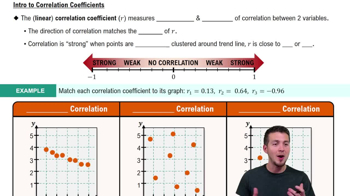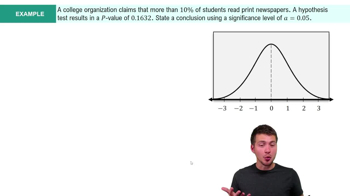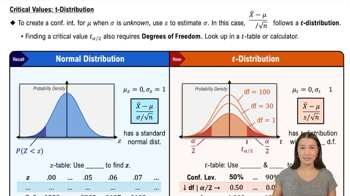A marketing researcher analyzed advertising budget vs. monthly sales revenue for small retail stores and found that typically the stores that spent more on advertising saw higher sales revenues. However, the relationship wasn't perfect - some stores advertised more but saw fewer sales due to poor location, customer preferences, or bad timing. Which of the following is the most likely value for the correlation coefficient between advertising budget and sales revenue?
Table of contents
- 1. Intro to Stats and Collecting Data1h 14m
- 2. Describing Data with Tables and Graphs1h 55m
- 3. Describing Data Numerically2h 5m
- 4. Probability2h 16m
- 5. Binomial Distribution & Discrete Random Variables3h 6m
- 6. Normal Distribution and Continuous Random Variables2h 11m
- 7. Sampling Distributions & Confidence Intervals: Mean3h 23m
- Sampling Distribution of the Sample Mean and Central Limit Theorem19m
- Distribution of Sample Mean - Excel23m
- Introduction to Confidence Intervals15m
- Confidence Intervals for Population Mean1h 18m
- Determining the Minimum Sample Size Required12m
- Finding Probabilities and T Critical Values - Excel28m
- Confidence Intervals for Population Means - Excel25m
- 8. Sampling Distributions & Confidence Intervals: Proportion1h 12m
- 9. Hypothesis Testing for One Sample3h 29m
- 10. Hypothesis Testing for Two Samples4h 50m
- Two Proportions1h 13m
- Two Proportions Hypothesis Test - Excel28m
- Two Means - Unknown, Unequal Variance1h 3m
- Two Means - Unknown Variances Hypothesis Test - Excel12m
- Two Means - Unknown, Equal Variance15m
- Two Means - Unknown, Equal Variances Hypothesis Test - Excel9m
- Two Means - Known Variance12m
- Two Means - Sigma Known Hypothesis Test - Excel21m
- Two Means - Matched Pairs (Dependent Samples)42m
- Matched Pairs Hypothesis Test - Excel12m
- 11. Correlation1h 6m
- 12. Regression1h 50m
- 13. Chi-Square Tests & Goodness of Fit1h 57m
- 14. ANOVA1h 57m
11. Correlation
Correlation Coefficient
Problem 13.6.2
Textbook Question
Rank Correlation Use the ranks from Exercise 1 to find the value of the rank correlation coefficient. Also, use a 0.05 significance level and find the critical value of the rank correlation coefficient. What do you conclude about correlation?
 Verified step by step guidance
Verified step by step guidance1
Step 1: Recall the formula for the Spearman rank correlation coefficient (ρ), which is given by: , where is the difference between the ranks of each pair of data points, and is the number of data pairs.
Step 2: Use the ranks provided in Exercise 1 to calculate the differences () between the two sets of ranks for each data pair. Then, square each difference to find .
Step 3: Sum all the squared differences () and substitute this value, along with the total number of data pairs (), into the formula for to compute the rank correlation coefficient.
Step 4: Determine the critical value for the Spearman rank correlation coefficient at a significance level of 0.05. This value can be found in a statistical table for Spearman's rank correlation, based on the sample size ().
Step 5: Compare the calculated rank correlation coefficient () to the critical value. If the absolute value of is greater than the critical value, reject the null hypothesis and conclude that there is a significant correlation. Otherwise, fail to reject the null hypothesis and conclude that there is no significant correlation.
 Verified video answer for a similar problem:
Verified video answer for a similar problem:This video solution was recommended by our tutors as helpful for the problem above
Video duration:
4mPlay a video:
Was this helpful?
Key Concepts
Here are the essential concepts you must grasp in order to answer the question correctly.
Rank Correlation Coefficient
The rank correlation coefficient, often represented by Spearman's rho, measures the strength and direction of association between two ranked variables. It assesses how well the relationship between the variables can be described using a monotonic function. Unlike Pearson's correlation, which requires interval data, Spearman's can be used with ordinal data, making it suitable for ranked datasets.
Recommended video:
Guided course

Correlation Coefficient
Significance Level
The significance level, commonly denoted as alpha (α), is the threshold used to determine whether a statistical result is significant. In this context, a 0.05 significance level indicates a 5% risk of concluding that a correlation exists when there is none (Type I error). It helps researchers decide whether to reject the null hypothesis, which typically states that there is no correlation between the variables.
Recommended video:
Guided course

Step 4: State Conclusion Example 4
Critical Value
The critical value is a point on the scale of the test statistic that defines the boundary for rejecting the null hypothesis. For rank correlation, the critical value is determined based on the chosen significance level and the sample size. If the calculated rank correlation coefficient exceeds this critical value, it suggests a statistically significant correlation, leading to a rejection of the null hypothesis.
Recommended video:

Critical Values: t-Distribution

 5:43m
5:43mWatch next
Master Correlation Coefficient with a bite sized video explanation from Patrick
Start learningRelated Videos
Related Practice
Multiple Choice
